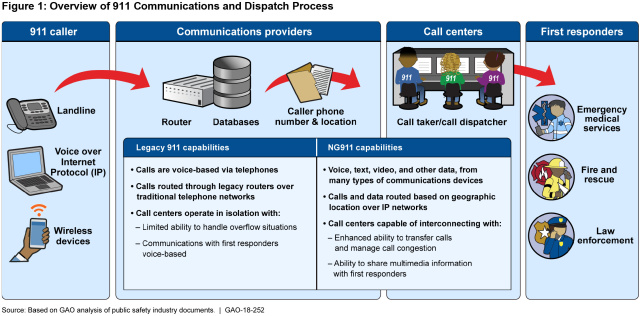911 - What Is Your Emergency?
Each year, Americans make approximately 240 million calls to 911—of those, 80% are from wireless devices. The existing 911 system, however, relies on aging infrastructure that is not designed to accommodate modern communications technologies.
As a result, states and localities are upgrading to the next generation of services, commonly known as Next Generation 911.
We looked at what the federal government is doing to help states implement these new systems.
What’s new?
In 2015 about half of all states had started transitioning to the new system, according to responses to the National Highway Traffic Safety Administration’s National 911 Program’s survey of states that year.
Benefits of these new systems include better communication with callers, more resilient 911 operations, and enhanced information sharing among 911 call centers and first responders. Call centers using these new systems will be able to receive voice calls and accept various forms of data, such as text messages, images, video, and vehicle crash data. Such information can help to facilitate quick and accurate dispatch of first responders, and can help in situations where a 911 caller is unable to speak.
How does it work?
Dialing 911 triggers a series of events that result in a first responder’s coming to help you. That doesn’t change under the new system. Calls will still reach call centers and trained personnel will still dispatch first responders.
However, Next Generation 911 is capable of routing calls and other data through internet protocol–based networks instead of traditional telephone networks. As you can see in the figure, this allows call centers to process and share more information about emergencies, including more accurate location information.
Making the switch
States and localities—the primary providers of 911 services—are responsible for implementing the new system, but federal agencies are helping too. For example, the National 911 Program leads the national effort to eventually connect approximately 6,000 independently operated 911 call centers into a nationwide Next Generation 911 system. The National 911 Program also provides national leadership for the transition, as well as information on grant resources, technology standards, and planning guides for states and localities.
Next steps
The National 911 Program is planning to work with other agencies to figure out what the federal government should do next in order to support implementation. As part of this process, we recommended that the National 911 Program make sure it identifies who will do what and develops an implementation plan for moving forward to improve this lifesaving service. NHTSA agreed with our recommendation.
- Comments on GAO’s WatchBlog? Contact blog@gao.gov.
GAO Contacts
Related Products

GAO's mission is to provide Congress with fact-based, nonpartisan information that can help improve federal government performance and ensure accountability for the benefit of the American people. GAO launched its WatchBlog in January, 2014, as part of its continuing effort to reach its audiences—Congress and the American people—where they are currently looking for information.
The blog format allows GAO to provide a little more context about its work than it can offer on its other social media platforms. Posts will tie GAO work to current events and the news; show how GAO’s work is affecting agencies or legislation; highlight reports, testimonies, and issue areas where GAO does work; and provide information about GAO itself, among other things.
Please send any feedback on GAO's WatchBlog to blog@gao.gov.





